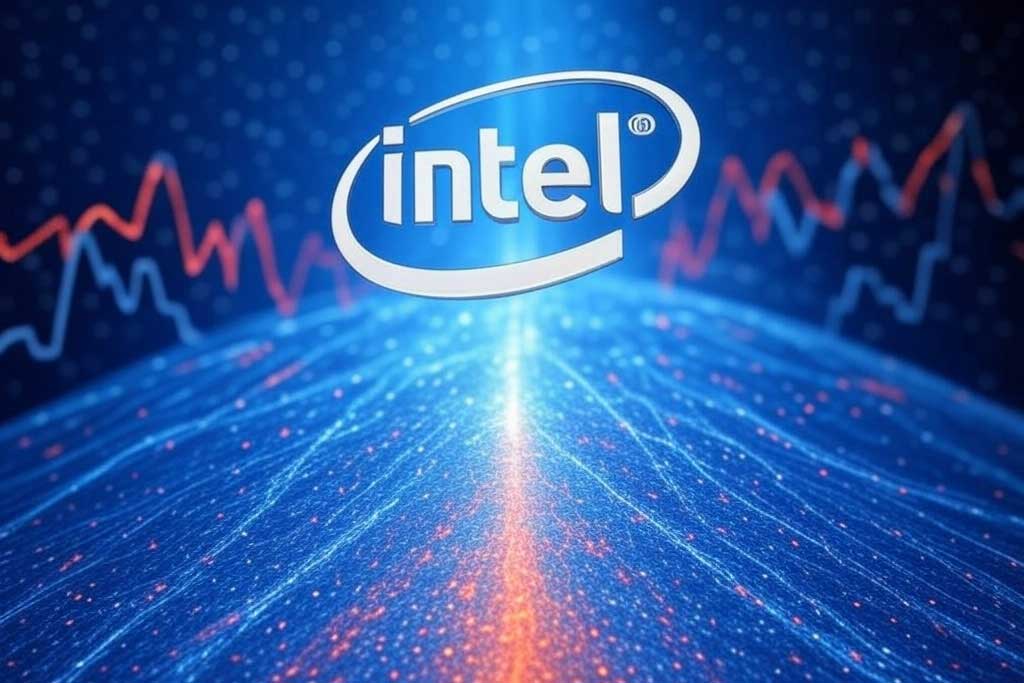San Francisco, CA – March 27, 2025 For decades, Intel Corporation stood as the undisputed leader of the semiconductor industry, a Silicon Valley titan that shaped the technology industry with its groundbreaking innovations. From powering the personal computer revolution to dominating data centers, Intel’s chips were the heartbeat of modern computing. However, in recent years, the company has faced a roller-coaster ride of challenges, marked by a decline in market share, operating losses in its foundry business, and fierce competition from rivals like Advanced Micro Devices (AMD) and Taiwan Semiconductor Manufacturing Company (TSMC). As of March 20, 2025, Intel’s story is one of early success, significant investments, and a struggle to adapt to the new name of the game: artificial intelligence (AI) and advanced manufacturing processes. So, what happened to Intel, and can it reclaim its former glory?
The Rise of Intel: A Legacy of Dominance
Intel’s ascent began in 1968, founded by Gordon Moore and Robert Noyce in the heart of Silicon Valley. The company quickly established itself as a pioneer in semiconductor technology, with its Intel chips becoming the standard for personal computers in the 1980s and 1990s. The iconic “Intel Inside” campaign solidified its position as a household name, synonymous with computing power. For a long time, Intel held the lion’s share of the market for PC chips, with Intel’s PC chips powering the majority of desktops and laptops worldwide.
The company’s core business thrived on exponential growth, driven by Moore’s Law—the prediction that the number of transistors on a chip would double every two years. Intel leveraged this principle to deliver faster, more powerful processors, cementing its role as the undisputed leader in the semiconductor sector. By the early 2000s, Intel had expanded into data centers, a booming market fueled by the rise of the internet and cloud computing. Its market cap soared, and Intel’s stock became a darling of Wall Street, with shares of Intel delivering consistent returns to investors.
Intel’s early success wasn’t just about technology—it was about strategy. The company vertically integrated its operations, designing and manufacturing its chips in-house. This allowed Intel to control the entire manufacturing process, ensuring quality and innovation. For years, this business model gave Intel a competitive edge, as it could rapidly iterate on chip designs and bring new products to market.
Cracks in the Foundation
Despite its dominance, Intel began to show signs of strain in the 2010s. The first cracks appeared in its manufacturing process, once a cornerstone of its success. Intel struggled to keep pace with the nm process—a measure of transistor size—as competitors like TSMC and Samsung pushed ahead with smaller, more efficient chips. For the first time, Intel fell behind in delivering leading-edge logic chips, a critical component for high-performance computing. TSMC, in particular, surged ahead, mastering the 7nm and 5nm processes while Intel lagged with its 10nm process, which faced repeated delays.
This manufacturing stumble had ripple effects. Advanced Micro Devices (AMD), Intel’s longtime rival, capitalized on Intel’s missteps. AMD partnered with TSMC to produce chips using advanced manufacturing facilities, allowing it to deliver faster, more power-efficient processors. In recent years, AMD has steadily eroded Intel’s share of the PC and data center markets. According to Bernstein analysts, AMD’s market share in the CPU market grew from 18% in 2017 to over 30% by 2023, while Intel’s share plummeted.
The rise of the AI gold rush further exposed Intel’s vulnerabilities. The AI boom, driven by the demand for AI chips and AI accelerators, caught Intel off guard. Companies like Nvidia dominated the market for GPUs used in artificial intelligence, while Intel struggled to pivot. Patrick Moorhead, a senior analyst and research director at Moor Insights & Strategy, noted that Intel’s failure to capitalize on the AI boom was a significant missed opportunity. “The new name of the game is AI, and Intel is playing catch-up,” Moorhead said in a detailed report last year.
The Foundry Business: A Bold Bet
In 2021, Intel, under the leadership of CEO Pat Gelsinger, announced a bold new strategy: Intel Foundry. Gelsinger, who took the helm after a 30-year career at Intel, aimed to transform the company into a leading foundry business, competing directly with TSMC and Samsung. The plan was ambitious—Intel would manufacture chips for external customers, not just its own designs, and invest heavily in new manufacturing facilities in the United States. This move was backed by the U.S. government, which saw Intel’s expansion as a matter of national security.
The federal government, through the CHIPS Act and the Science Act, poured billions into Intel to bolster domestic semiconductor production. The Biden administration, in particular, prioritized bringing advanced chips manufacturing back to American soil, fearing reliance on foreign manufacturers like TSMC posed a risk amid geopolitical tensions. Last year, the Commerce Department awarded Intel significant grants, with more funding expected next year. These major investments were meant to help Intel build new factories in Arizona, Ohio, and other states, creating thousands of jobs and boosting the United States’ position in the global semiconductor sector.
However, the Intel Foundry initiative has been a financial drag. Last quarter, Intel Foundry reported a $5 billion operating loss, a staggering figure that alarmed investors. The Wall Street Journal reported last month that Intel’s foundry business was struggling to attract external customers, with major chip companies hesitant to trust Intel with their chip designs. SK Hynix, a South Korean memory chip maker, and other potential partners have stuck with TSMC, citing its proven track record. Bloomberg analysts have questioned whether Intel can turn its foundry business around, with some predicting it may take years to achieve profitability.
Leadership Challenges and Stock Price Woes
CEO Pat Gelsinger’s tenure has been a roller-coaster ride. When he took over in 2021, Intel’s stock surged on hopes of a turnaround. Gelsinger’s vision of revitalizing Intel’s manufacturing and embracing the AI gold rush resonated with investors. However, the reality has been far more challenging. Posts on X reflect a growing sentiment of frustration with Intel’s leadership, with some users pointing to Gelsinger’s forced departure in December 2024 as a sign of deeper troubles. According to these posts, Intel’s board ousted Gelsinger after the disastrous rollout of its 13th and 14th generation chips, which suffered from degradation issues, and the company’s inability to compete with AMD and Nvidia in AI and enterprise markets.
Intel’s stock price has taken a beating as a result. Shares of Intel, which traded above $60 in early 2021, have fallen to around $20 as of March 20, 2025. The consensus price target, according to Bank of America analysts, is now just $25, reflecting a lack of confidence in Intel’s near-term prospects. Intel’s market cap, once over $300 billion, has shrunk to under $100 billion, a stark contrast to Nvidia’s trillion-dollar valuation. The company’s balance sheet, while still showing positive free cash flow, is under pressure from the massive costs of its foundry expansion.
The stock price decline has also been exacerbated by Intel’s declining revenues. In the fourth quarter of 2024, Intel’s revenues fell 10% year-over-year, driven by weak demand for Intel’s PC chips and data center processors. Goldman Sachs analysts noted that Intel is losing ground in the data center market, where AMD and Nvidia are capturing share with their AI-focused offerings. The potential of INTC as an investment has dimmed, with some financial firms downgrading the stock. Trefis, a research team known for its high-quality portfolio analysis, recently published an in-depth investment research report suggesting that Intel’s fair value may be closer to $30, but only if the company can execute on its foundry strategy.
The AI Challenge and Market Dynamics
The AI gold rush has redefined the technology industry, and Intel has struggled to keep up. While Intel has made strides with its AI accelerators, such as the Gaudi series, it remains a distant third to Nvidia and AMD in the AI chip market. Nvidia’s GPUs are the gold standard for training large language models, and AMD’s Instinct accelerators have gained traction in data centers. Intel, meanwhile, is seen as the cheapest AI stock, but that label comes with a caveat: its offerings lack the performance and ecosystem support of its rivals.
The coming years will be critical for Intel’s AI strategy. The company has invested heavily in groundbreaking AI technologies, including new chip designs optimized for machine learning. However, the market is skeptical. Bernstein analysts have warned that Intel’s late entry into the AI chip market may limit its ability to capture significant share. “The AI boom waits for no one,” a senior analyst at Bernstein noted in a detailed report last week. “Intel needs to deliver a higher price-to-performance ratio to compete.”
Government Support and Geopolitical Stakes
The U.S. government’s support for Intel has been a double-edged sword. On one hand, the CHIPS Act and Science Act have provided billions in funding, enabling Intel to break ground on new factories. These investments are expected to create a metric tons of annual copper demand, as chip manufacturing requires vast amounts of raw materials. The American government sees Intel as a key player in reducing reliance on foreign manufacturers, especially given national security concerns around Taiwan, where TSMC is based.
On the other hand, Intel’s reliance on federal government subsidies has drawn scrutiny. Former President Donald Trump, who has been vocal about bringing manufacturing back to the U.S., criticized Intel in 2024 for its slow progress, reportedly calling its new Ohio factory “a go-kart track” in a jab at its scale. The Commerce Department has also expressed frustration with Intel’s execution, with some officials privately questioning whether the company can deliver on its promises.
A Path Forward?
Despite its challenges, there is good news for Intel. The company still has a strong core business in PCs and data centers, and its brand remains synonymous with quality in many circles. Intel’s investments in advanced chips, such as its upcoming 3nm process, could help it regain ground in the coming years. Additionally, the influx of talent guarantees that Intel has the human capital to innovate—recent hires from TSMC and other chip companies have bolstered its engineering teams.
Intel is also exploring new revenue streams. Its quarterly newsletter’s strategy, which offers exclusive access to industry insights, has gained traction among investors, with the price of its premium readership newsletter reflecting strong demand. The company has also experimented with ad-free browsing initiatives, though these are unlikely to move the needle on its balance sheet.
Analysts remain cautiously optimistic. A detailed report from Goldman Sachs last week highlighted Intel’s potential to achieve profitability in its foundry business by 2027, provided it can attract external customers. Partnerships with companies like SK Hynix or even AMD could help Intel scale its foundry operations. Moreover, Intel’s focus on major new copper mines to secure raw materials could mitigate supply chain risks, ensuring a steady flow of resources for its manufacturing facilities.
Looking Ahead
Intel’s rise and decline is a cautionary tale of what happens when an industry leader fails to adapt to seismic shifts. The company’s early success was built on innovation and a vertically integrated business model, but the new name of the game—AI, advanced manufacturing, and foundry services—has exposed its weaknesses. Former CEO Pat Gelsinger’s ambitious vision to transform Intel into a foundry powerhouse has yet to bear fruit, and his departure in 2024 has left the company at a crossroads.
Yet, Intel’s story is far from over. With significant investments from the U.S. government, a renewed focus on AI, and a 30-day money-back guarantee on its innovation promises (metaphorically speaking), Intel has the tools to stage a comeback. The semiconductor sector remains fiercely competitive, but Intel’s legacy and resources give it a fighting chance. Whether it can reclaim its position as the undisputed leader—or at least carve out a new role in the technology industry—will depend on its ability to execute in the coming years. For now, Intel’s journey is a reminder that even giants can stumble, but with the right strategy, they can rise again.
Related:


